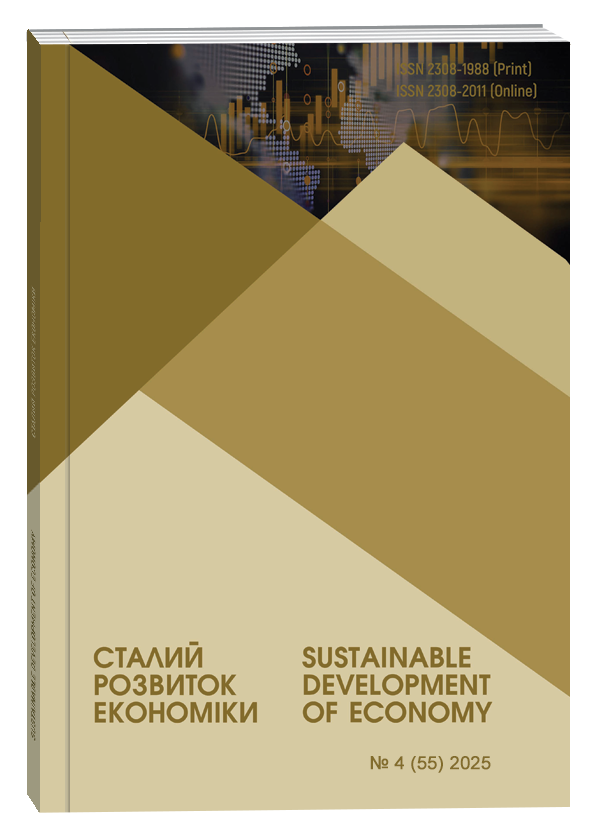ECONOMIC AND MATHEMATICAL MODELING: SYNERGY OF ANALYTICS, MANAGEMENT AND ARTIFICIAL INTELLIGENCE
Abstract
The purpose of the research is to develop a comprehensive theoretical and methodological framework for designing, validating, and implementing adaptive economic and mathematical models aimed at managing socio-economic systems under conditions of uncertainty and rapid digital transformation. The article explores economic and mathematical modeling as an integrated decision-making tool that combines analytical rigor with technological innovation, highlighting its capacity to address complex managerial tasks in dynamic environments. Particular emphasis is placed on the synergistic integration of business analytics, big data processing, and artificial intelligence technologies, enabling more accurate forecasting, resource optimization, and strategic planning. A generalized multilevel framework for model construction is proposed, incorporating the use of advanced digital analytical platforms and cloud-based environments for real-time processing. Special focus is given to intelligent algorithms—neural networks, ensemble methods, hybrid AI systems—that enhance capabilities in risk assessment, production process optimization, cost control, and scenario analysis. The research systematizes state-of-the-art software tools (Python, R, SAS, Tableau, Power BI) that support deployment and continuous refinement of models, integrating verification and adaptation procedures grounded in the principle of information invariance. A comparative analysis between classical mathematical approaches and advanced AI-driven methods (machine learning, reinforcement learning, fuzzy logic) demonstrates the significant performance gains in predictive accuracy and decision support. The findings confirm that the synergy of mathematical modeling, digital analytics, and AI not only improves the efficiency and resilience of strategic decision-making but also uncovers latent data patterns, reduces cognitive bias, and fosters the creation of adaptive, innovation-oriented management systems. This underlines the importance of integrated modeling as a cornerstone for economic forecasting, strategic planning, and sustainable enterprise growth in the digital economy.
References
Прокопенко Н., Круш К.-К. Економіко-математичне моделювання стратегічної зрілості проєктного управління підприємств енергетичної галузі. Економіка та суспільство. 2025. № 74. DOI: https://doi.org/10.32782/2524-0072/2025-74-3
Гур’янова Л. С., Пушкар О. І., Панасенко О. В., Орлова А. О. Моделювання динаміки ринку в умовах цифрової економіки. Бізнес Інформ. 2025. № 2. С. 284–294. DOI: https://doi.org/10.32983/2222-4459-2025-2-284-294.
Янковий О. Г. Латентні ознаки в економіці: монографія. Одеса: Атлант, 2015. 268 с.
Якімова Н. А. Математичні методи прогнозування в економіці та бізнесі. Одеса: ОНУ ім. І. І. Мечникова. 2024. 211 с.
Дудник О. Економіко-математичне моделювання як інструмент прогнозування впровадження стратегій розвитку в аграрному секторі. Modeling the Development of the Economic Systems. 2025. № 2. С. 52–59.
Куперман В. В. Багатовимірний статистичний метод побудови глобального критерію оптимальності виробничої програми. Вісник соц.-екон. Досліджень ОНЕУ. 2012. № 45. С. 126–131.
Chepurna O., Cherevko Y., Kuleshova Y. On Information Geometry Methods for Data Analysis. Geometry, Integrability and Quantization. 2024. Vol. 29. P. 11–22. DOI: https://doi.org/10.7546/giq-29-2024-11-22
Babii A., Ghysels E., Striaukas J. Machine Learning in Macroeconomics and Finance. SSRN. No. 4547321. DOI: https://doi.org/10.2139/ssrn.4547321
Oancea B. Advancing GDP Forecasting Using Deep Learning. arXiv preprint. 2025. URL: https://arxiv.org/abs/2502.19807 (дата звернення: 20.07.2025).
Sharma P. An Application of AI Models in Macroeconomic Analysis and Forecasting. IJSRD. 2024. Vol. 12(5). URL: https://ijsdr.org/papers/IJSDR2412051.pdf (дата звернення: 20.07.2025).
Manshur Al Ahmad A. S., et al. Distributed Macroeconomic Modeling Using AI.. EAI Endorsed Transactions. 2023. DOI: https://doi.org/10.4108/eetsis.4452 (дата звернення: 20.07.2025).
Chen Q. et al. Can AI Master Econometrics? MetaGPT for Structured Macroeconomic Analysis. 2025. arXiv preprint. URL: https://arxiv.org/abs/2506.00856 (дата звернення: 20.07.2025).
Ramaharo F., Rasolofomanana G. GDP Nowcasting for Madagascar Using ML. 2023. arXiv preprint. URL: https://arxiv.org/abs/2401.10255 (дата звернення: 20.07.2025).
Alexeeva A. et al. Deep Reinforcement Learning Control of Macroeconomic Chaos. 2023. arXiv preprint. URL: https://arxiv.org/abs/2302.12019 (дата звернення: 20.07.2025).
Wamba S. F., Kala Kamdjoug J. R., Akter S. et al. How artificial intelligence and big data analytics can support sustainable development goals (SDGs): A comprehensive literature review. Technological Forecasting and Social Change. 2023. Vol. 190. DOI: https://doi.org/10.1016/j.techfore.2023.122369
Guo Y., Tang J., Ye X., et al. A hybrid machine learning approach for financial risk prediction. Expert Systems with Applications. 2024. Vol. 232. DOI: https://doi.org/10.1016/j.eswa.2023.121239
Kaelbling L. P., Littman M. L., Moore A. W. Reinforcement Learning: A Survey. Journal of Artificial Intelligence Research. 1996. Vol. 4. DOI: https://doi.org/10.1613/jair.301
Francois-Lavet V., Henderson P., Islam R. et al. An Introduction to Deep Reinforcement Learning. Foundations and Trends in Machine Learning. 2018. Vol. 11(3–4). DOI: https://doi.org/10.1561/2200000071
Prokopenko N., Krush K. (2025). Ekonomiko-matematychne modeliuvannia stratehichnoi zrilosti proiektnoho upravlinnia pidpryiemstv enerhetychnoi haluzi [Economic and Mathematical Modeling of Strategic Maturity of Project Management in Energy Enterprises]. Ekonomika ta suspilstvo – Economy and Society, vol. 74. DOI: https://doi.org/10.32782/2524-0072/2025-74-3 (in Ukrainian), (accessed July 20, 2025)
Huriianova L. S., Pushkar O. I., Panasenko O. V., Orlova A. O. (2025). Modeliuvannia dynamiky rynku v umovakh tsyfrovoi ekonomiky [Market Dynamics Modeling in the Digital Economy]. Biznes Inform – Business Inform, vol. 2, pp. 284–294. DOI: https://doi.org/10.32983/2222-4459-2025-2-284-294 (in Ukrainian), (accessed July 20, 2025)
Yankovyi O. H. (2015). Latentni oznaky v ekonomitsi: monohrafiia [Latent Features in the Economy: Monograph]. Odesa: Atlant, 268 p. (in Ukrainian)
Yakimova N. A. (2024). Matematychni metody prohnozuvannia v ekonomitsi ta biznesi [Mathematical Forecasting Methods in Economics and Business]. Odesa: ONU im. I. I. Mechnykova, 211 p. (in Ukrainian)
Dudnyk O. (2025). Ekonomiko-matematychne modeliuvannia yak instrument prohnozuvannia vprovadzhennia stratehii rozvytku v ahrarnomu sektori [Economic and Mathematical Modeling as a Tool for Forecasting Strategy Implementation in the Agricultural Sector]. Modeling the Development of the Economic Systems, vol. 2, pp. 52–59. (in Ukrainian)
Kuperman V. V. (2012). Bahatovymirnyi statystychnyi metod pobudovy hlobalnoho kryteriiu optymalnosti vyrobnychoi prohramy [Multivariate Statistical Method for Constructing a Global Optimality Criterion for the Production Program]. Visnyk sots.-ekon. doslidzhen – Bulletin of Socio-Economic Research, vol. 45, pp. 126–131. (in Ukrainian)
Chepurna O., Cherevko Y., Kuleshova Y. (2024). On Information Geometry Methods for Data Analysis. Geometry, Integrability and Quantization, vol. 29, pp. 11–22. DOI: https://doi.org/10.7546/giq-29-2024-11-22
Babii A., Ghysels E., Striaukas J. (2023). Machine Learning in Macroeconomics and Finance. SSRN. No. 4547321. DOI: https://doi.org/10.2139/ssrn.4547321 (accessed July 20, 2025)
Oancea B. (2025). Advancing GDP Forecasting Using Deep Learning. arXiv preprint. Available at: https://arxiv.org/abs/2502.19807 (accessed July 20, 2025)
Sharma P. (2024). Machine Learning Models in Macroeconomics. International Journal of Scientific Development and Research – IJSRD, vol. 12(5). Available at: https://ijsdr.org/papers/IJSDR2412051.pdf (accessed July 20, 2025)
Manshur Al Ahmad A. S., et al. (2023). Distributed Macroeconomic Modeling Using AI. EAI Endorsed Transactions on Scalable Information Systems. DOI: https://doi.org/10.4108/eetsis.4452 (accessed July 20, 2025)
Chen Q., et al. (2025). Can AI Master Econometrics? MetaGPT for Structured Macroeconomic Analysis. arXiv preprint. Available at: https://arxiv.org/abs/2506.00856 (accessed July 20, 2025)
Ramaharo F., Rasolofomanana G. (2023). GDP Nowcasting for Madagascar Using ML. arXiv preprint. Available at: https://arxiv.org/abs/2401.10255 (accessed July 20, 2025)
Alexeeva A., et al. (2023). Deep Reinforcement Learning Control of Macroeconomic Chaos. arXiv preprint. Available at: https://arxiv.org/abs/2302.12019 (accessed July 20, 2025)
Wamba S. F., Kala Kamdjoug J. R., Akter S., et al. (2023). How Artificial Intelligence and Big Data Analytics Can Support Sustainable Development Goals (SDGs): A Comprehensive Literature Review. Technological Forecasting and Social Change, vol. 190. DOI: https://doi.org/10.1016/j.techfore.2023.122369
Guo Y., Tang J., Ye X., et al. (2024). A Hybrid Machine Learning Approach for Financial Risk Prediction. Expert Systems with Applications, vol. 232. DOI: https://doi.org/10.1016/j.eswa.2023.121239
Kaelbling L. P., Littman M. L., Moore A. W. (1996). Reinforcement Learning: A Survey. Journal of Artificial Intelligence Research, vol. 4. DOI: https://doi.org/10.1613/jair.301
Francois-Lavet V., Henderson P., Islam R., et al. (2018). An Introduction to Deep Reinforcement Learning. Foundations and Trends in Machine Learning, vol. 11(3–4). DOI: https://doi.org/10.1561/2200000071


